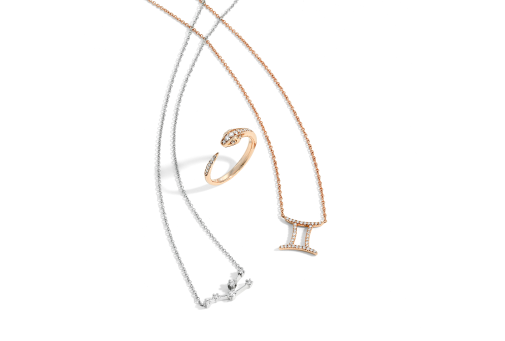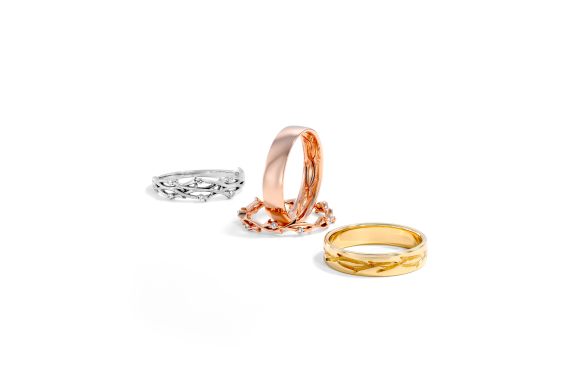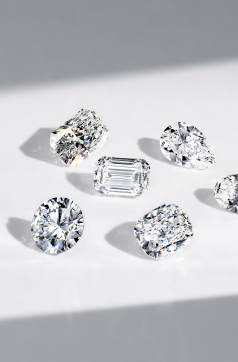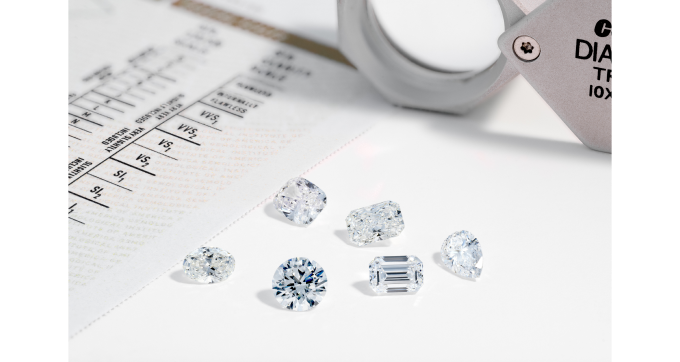Everything You Need to Know About Platinum Engagement Rings
Education Center
Education CenterPlatinum jewelry has been adored and prized for centuries, appreciated for its stunning beauty, rarity, and durability. One of its earliest recorded appearances was in the court of King Louis XVI of France, so it was soon associated with royalty. King Louis even proclaimed that it was fit only for kings.
Today, platinum is indeed referred to as the ‘king of metals,’ but for a different reason. It is one of the densest, heaviest, and strongest metals on the planet, making it an ideal choice for creating high-quality and long-lasting jewelry. Learn more about platinum jewelry, its unique characteristics, and how you can keep yours looking flawless.
What is Platinum?
Platinum is a dense, silvery-white, and highly valuable metal made of 95% pure platinum, 3% copper, and 2% cobalt. When used to make jewelry, its purity, durability, and beauty are unmatched. If that isn’t enough, check out the advantages below!
• Platinum is highly resistant to wear and tear, scratches, and corrosion, making it an ideal choice for daily wear jewelry.
• Being a denser metal, it’s perfect for substantial and impressive jewelry pieces like engagement rings and statement bracelets or eternity rings.
• It’s hypoallergenic, making it an excellent option for people with sensitive skin. Platinum does not contain any alloys that could cause skin irritations, rashes, or allergic reactions.
Platinum's luster and brightness also don’t fade over time. Unlike white gold, it won’t tarnish, fade, or discolor after years of use, ensuring that platinum jewelry retains its beauty and value for a lifetime.
How is Platinum Different From White Gold?
Both platinum and white gold are luminous, luxurious, and a similar shade of silvery white. So why does platinum jewelry command a higher price?
While platinum as a raw material is cheaper per ounce than gold, it’s more expensive as jewelry. This is because more of it is used when making (for example) a ring, resulting in a more valuable piece. Overall, platinum is more difficult to process and the finished item can be even twice the weight of white gold due to increased density.
Now let’s look at some other differences:
• Rarity: Platinum can only be found in limited quantities in a few locations around the world. Approximately 200-250 metric tons of platinum are produced yearly compared to 3,100 metric tons of gold.
• Purity: Platinum is a naturally occurring metal that is almost 100% pure, while white gold is typically alloyed with other metals, such as copper or silver, to make it stronger and more durable. This is why platinum jewelry is more expensive than white gold and other precious metals.
• Durability: White gold needs rhodium plating and a lot of maintenance and care to maintain its appearance. Platinum, on the other hand, is a naturally white metal that retains its brilliant white luster without plating or extra maintenance. Platinum is also denser, heavier, and more damage-resistant than white gold, which is more susceptible to tarnishing and scratches.
What to Look for When Choosing Platinum Jewelry?
When choosing platinum jewelry, there are a few important factors to consider to ensure that you are getting a high-quality piece. They include:
• Hallmarks: Look for the hallmark that indicates the authenticity of the platinum jewelry. Since 1975, all platinum jewelry weighing more than 0.5 grams has been marked with a hallmark or finesse mark, a process overseen by the Platinum Guild International (PGI). High-quality platinum jewelry will have a purity level of at least 90% platinum. It can either be written as Pt or PLAT. This notation may be preceded or followed by numbers like 900, 950, or 999 to indicate purity level.
• Design and Craftsmanship: Platinum is a malleable metal that can be worked into intricate designs and shapes. You should look for platinum jewelry that has been crafted with precision and attention to detail, with no visible flaws or defects.
There are a couple of tests you can run to ensure you’re getting a genuine platinum piece:
• Scratch Test: This test helps confirm that the piece you’re buying is pure platinum. When you’re checking it out, run your nail along the surface. If the metal scratches, it’s likely silver or platinum alloyed with silver. Pure platinum is much harder.
• Magnet Test: Platinum is nonmagnetic. To test the purity of your platinum jewelry, bring it near a magnet. If it reacts, the jewelry is not pure platinum. In its purest form, platinum is a paramagnetic metal- if your piece sticks to a magnet, it may have been combined with magnetic alloys or other magnetic or corrosive metals.
Care and Maintenance of Platinum Jewelry
Platinum is a resilient and long-lasting metal, but like all fine jewelry, it requires proper care and maintenance to keep it looking its best. Here are some tips for caring for and maintaining platinum jewelry:
• Regular Cleaning: To remove dirt and grime from platinum jewelry, use warm, soapy water and a soft-bristled brush. It can also be soaked in a jewelry cleaner that is specifically formulated for platinum. Avoid using abrasive cleaners or rough cloths, as these can scratch the metal.
• Proper Storage: When not wearing platinum jewelry, store it in a soft pouch or lined jewelry box to preserve its surface and shine.
• Keep Away From Chemicals: Platinum can be damaged by chemicals, including household cleaning products, perfumes, and hairspray. Avoid wearing your platinum jewelry when working with chemicals, swimming in chlorinated pools, or using hot tubs.
• Professional Cleaning: While regular cleaning at home can help keep platinum jewelry looking its best, it's also a good idea to have it professionally cleaned and inspected by a jeweler every six months to a year. Keyzar Jewelry is pleased to offer free cleaning for all pieces that we sell!
• Repolishing: Over time, platinum jewelry may develop small scratches or lose its luster. Consider having it professionally re-polished to restore its shine and smooth out any scratches.
By following these tips, you can help ensure that your platinum jewelry stays in excellent condition for years to come.
Ready to Go Platinum?
If you’re looking for jewelry that’s as durable as it is elegant, there’s no way you can go wrong with platinum. Its natural silvery color, density, and resistance to wear and tear make it an ideal metal for engagement rings, wedding bands, and other jewelry items that are meant to last a lifetime. Whether you're looking for a classic solitaire diamond ring or a unique eternity ring, you can only win when you join Team Platinum.



